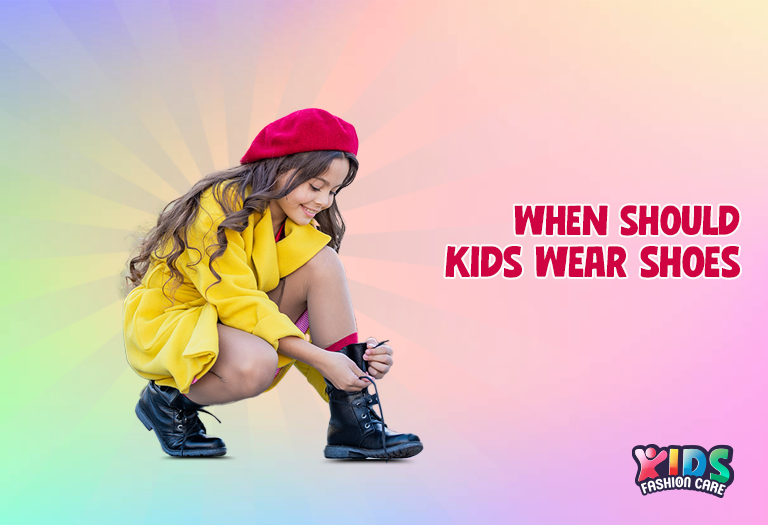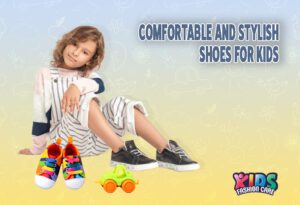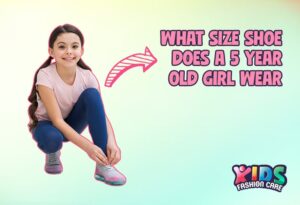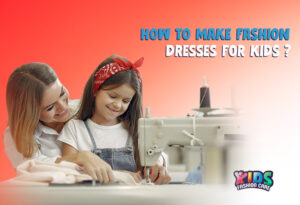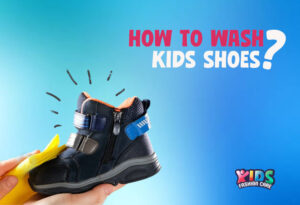Kids should wear shoes or other footwear by the age of 12 months to form a habit. However, depending on weather, occasion, and activities they must wear purpose-specific shoes. Also, while making wearing shoes a habit, look for quality materials and good buildings.
Introductions
If your infant has started standing, the time has come to take care of his/her tiny feet. The first and foremost is to get him/her used to wearing shoes. To ensure the kid’s foot comfort and maximize walking adventure, this article is dedicated to answering When Should Kids Wear Shoes? Let’s get started.
Table of Contents
When Should Babies Wear Shoes?
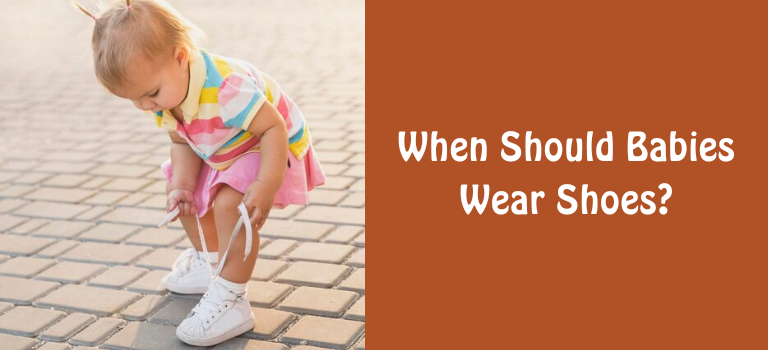
A study tells us that a baby’s feet tolerate 3 times more stress than an adult’s feet. So, it is crucial to understand the perfect timing for kids to wear shoes. But the confusing part is there is no specific age range, rather wholly based on several considerations. Here are some scenes to consider when babies should start wearing shoes.
Child’s growth
If your child has a fast growth rate, you need to start teaching them to wear shoes. However, do not be forceful about it. Because their feet need to develop, and barefoot activities naturally ensure that along with strengthening muscles.
Actions
When the infant has started standing or learning to walk which is between the ages of 8 months to 18 months, keep their movement smooth. Merge the learning with and without shoes. Don’t be disheartened if they are late to their leg movements, some children take time, and there is nothing wrong with it. But if you are concerned, talk to pediatricians.
Regular activities
If your child is a bit grown up, and s/he has walking stability, you can switch to more supportive shoes that are designed for the child’s walking, running, or other physical activities.
Protection
To shield the tiny baby’s feet, you have to consider having your child wear shoes. Shoes offer protection by keeping the feet firm and safe from dirt, and sharp things like broken glass, rocks, etc.
Why Do Kids Need Shoes?
It may seem common to appear that children need shoes for the same reason as an adult does. It’s true, but a child’s feet are softer. So, they need shoes for some more helpful reasons, whereas an adult may not need them because it is bad for toddlers to not wear shoes. Let’s check the reasons altogether.
- Offer protection: Shoes provide protection to the tiny feet, from the rough floor, dangerous things, hot or cold temperatures, etc.
- Feet support: A well-fitting shoes support kids’ growth, don’t cause foot aches or ankle pain, and support foot development as the kid grows.
- Safety: When kids are exposed to public places, such as schools, parks, and sports activities, shoes offer safety for their feet.
When Shouldn’t Kids Wear Shoes?
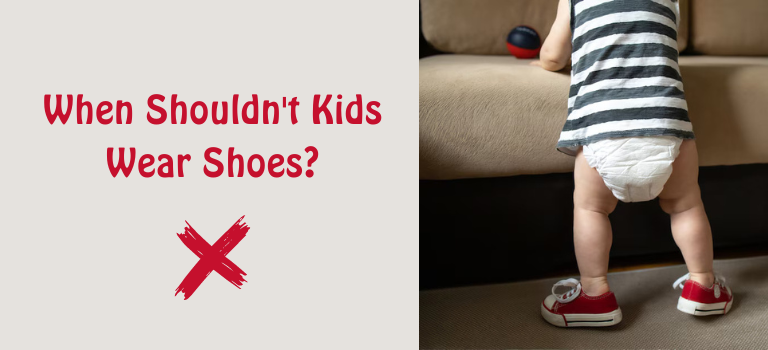
There are times when you should refrain your kids from wearing shoes. Let’s explore those situations then.
- They play indoors: When children are playing inside the house, the floor is neat and clean, letting them enjoy their inner world, and no need to burden them with shoes.
- Development of foot: Leave their feet open at night or the times when they are sleeping.
- Barefoot activities: When children are performing actions that are helpful to their development of foot, improve foot flexibility, keep the shoes away.
- Places that are safe for children: Indoor gaming platforms or kids’ zone-type environments where children can easily roam around, they don’t need to keep wearing shoes.
- During their regular activities: When the child is relaxing at home, studying, or passing their usual time, these are the times, you can skip the shoes for them.
Types of Kids’ Shoes
Now time has to decide what type of shoes you should be considering when letting your child wear, especially if it is his first pair of shoes. If you check e-commerce platforms, you will find a wide range of options available for parents to choose from. Among the vast variations, here are some shoes you can consider
- Pre-walking shoes: Generally made of cotton, soft fabrics, or woven of wool, this type of shoe isn’t for walking but rather for keeping the feet warm and protected.
- Walking shoes: When the babies are just starting to walk, there will be inconsistent tiny steps and stiff legs. Therefore, you need to aim for shoes that have a strong grip and support their actions well.
- Cruising shoes: These types of shoes help babies to pull them up. It generally has a puppy fat layer so that the baby’s soft foot bones stay safe.
- Crawling shoes: These shoes are made of soft materials that offer comfort and security while the baby crawls around the room.
- Toddler shoes: These types of shoes are lightweight. You will find canvas or leather shoes for toddlers.
- School shoes: White or black color school shoes are only for walkways to school. These are more formal and are not used in any physical activities.
- Athletic shoes: For ensuring child activities properly, aim for footwear like sneakers, hiking shoes, sandals, etc. Those are comfortable and ensure ventilation and airflow for the kids’ feet.
- Slip-on shoes: Wearing them doesn’t require any socks. These types of shoes are casual and offer flexibility. It is wearable in any type of situation.
Shoe Choices by Kids’ Ages
When choosing shoes for kids, their age should be a priority. Most shoe manufacturers and sellers have a kids’ shoe size conversion chart that is followed based on kids’ ages. Check below to learn about kids’ shoe choices based on their age.
Category: Infant
Age range: 0 to 12 months
Shoe choice: Shoes aren’t mandatory, a pair of socks will do the job pretty well. However, if the season is chilly, then you can have the baby wear cotton or fabric-made shoes that offer warmth to the feet.
Category: Toddler
Age range: 1 to 3 years of age
Shoe choice: Toddlers should be trained to wear shoes. So, look for shoes that are made of organic and breathable fabrics. So that it absorbs perspiration on the baby’s feet.
Category: Children
Age range: 4 to 9
Shoe choice: As kids of this age range are hyperactive, so look for shoes that are made of comfortable and long-lasting material. Also, buy shoes one size large, that have supportive heel functionality and adjustability.
Category: Pre-Teen
Age range: 10 to 12
Shoe choice: Explore different options, variations, and designs. Also, stick to your child’s choice, comfort, and personality. Make sure the shoes are supporting the child’s purpose and activity.
Expert Tips for Parents
If you are looking for shoes for your infants to wear, don’t just randomly buy the pair that your neighbor talks about. Every child’s physical adaptability is different. Therefore, you have to notice what your child demands.
Don’t worry. Here are some tips you can check up on while finding shoes for your little one.
Track down the baby’s growth
Babies grow really fast. So, don’t be emotional while seeing a pair of cute shoes just because it fits right. In the blink of an eye, the feet will grow.
Consider shoe material
Consider the fabric or material the shoes are made of. Are these of good quality and child-friendly?
Helpful to movements
Have separate activity-specific footwear for kids. For example, regular walking shoes, sports shoes, etc. Also, ensure that the pair is of good material so that while they are active, the shoe doesn’t cause blisters, calluses, or fungal infections.
Check the weather
While buying kids’ shoes, keep the weather in mind. For example, you can’t let the baby wear heavy shoes during summer. It might cause blisters and excess sweating on their feet; neither you can let him/her wear thin shoes during monsoon season or winter, as the weather is too cold for baby skin.
No-shoe time
Balance timing between shoe-wearing and walk barefoot. Bare feet help feet’s natural growth and adjusting to activities.
Have several pairs of children’s shoes
It is a wise decision if you keep a spare pair of shoes in hand. Always wearing one pair of shoes might make the kids disinterested in wearing them. Having extra pairs, such as indoor and outdoor shoes, will encourage them to wear them. Let’s say you buy them a pair of sneakers and tell them this is for playing. So, they know by instinct, that they need to wear exactly this pair of shoes when they are going to play.
Purchase a reasonably bigger size
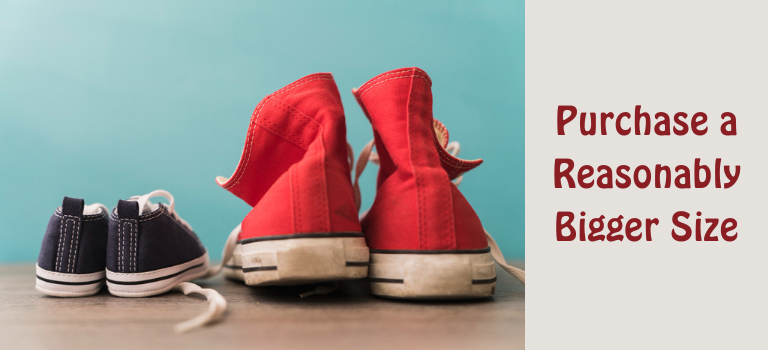
As mentioned earlier, children grow fast, so consider buying one size larger. But don’t aim too high just to save money. Maintain your purpose, which is to ensure the baby’s feet safety. Buy one or two sizes bigger, so that when you adjust the grip, this comfortably fits right in them.
Know what not to buy
Avoid purchasing shoes that are heavy, narrow, are too tight and rigid middle, loose-fitting, have too many designs and decoratives, need lace to adjust, tie down kid’s natural movement, made of materials that feel suffocating.
Consider shoe things
My last tip is to follow the things that need to be considered. Here are those.
Shoe design
Don’t buy a pair that has many designs. Picking up a cute pair of shoes might not be suitable for them. Prioritize choosing simple design shoes so that it doesn’t restrict their walking.
Shoe size
Check the shoe size to find the appropriate fit. So that the shoes fit well in their feet naturally, and don’t strain much on their feet. While buying from online stores, check for their size guide chart.
Shoes’ comfortability
Are the shoes comfortable enough for your kids? Is the insole, and inside part soft for their feet? While buying shoes, check for cushioning materials that offer optimal comfort and don’t hinder their foot activities.
Check the shoe’s build
Scrutinize the shoe properly, including the outer material, insole everything. Many unbranded sellers bring shoes that look comfortable on the surface but actually, those are not at all.
See the manufacturer’s reviews
If you are buying online, check reviews about the brands, and what other buyers are saying about these baby shoes. Are they comfortable for kids? Are there any issues with the users?
Shoe price
Shoes made of quality material may be pricey. Also, there are many sellers, who offer quality shoes at an affordable price. Do not buy pre-owned shoes, because used shoes are bad for toddlers as they may contain germs.
Frequently Asked Questions (FAQs)
Question: Can a 3-year-old put shoes on?
Answer: Yes, a 3-year-old is quite independent and confident. Thus, they can wear shoes by themselves. The interesting fact is, that they also can voice their opinion on the shoes and clothing they like to wear.
Question: What age can a child put on shoes?
Answer: When children can move their limbs by themselves, they try to wear the shoes by themselves as they watch their parents do so. By the age of 30 to 36 months, they can put on shoes alone. However, items like sandals or socks will take some time.
Question: Are kid’s shoe sizes important?
Answer: Yes, you should attentively take note of kids’ shoe sizes. Ensuring the right fit is as important as taking care of the tiny body. If the shoe size isn’t accurate, this might cause deformities in their tiny feet.
Question: Should children wear shoes all the time?
Answer: Children should not wear shoes all the time. Whenever they are inside the home, keep their feet bare. Whenever you are talking to them outside make sure they are wearing shoes, even if they have just started gross motor skills.
Conclusion
There you have it. Though in general there is a predictable age for babies to start wearing shoes, it depends on their growth and activities. However, whenever they can walk completely, this is a definite sign that wearing shoes is mandatory for them.

